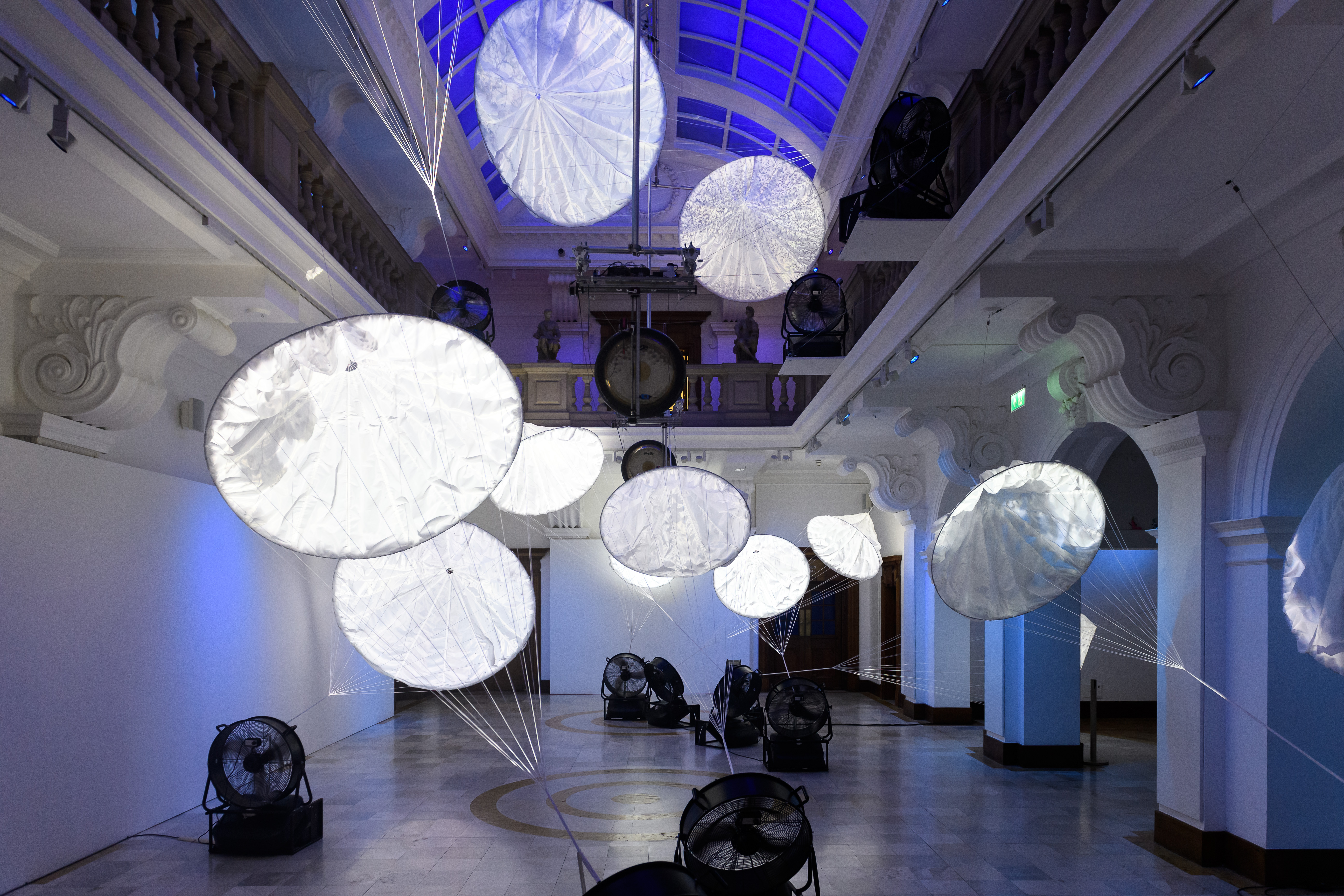


Heather Phillipson, Out of this World, 2024, at Glynn Vivian Art Gallery, Swansea, photo: Polly Thomas
Glynn Vivian Art Gallery, Swansea
Heather Phillipson’s expansive exhibition at Swansea’s Glynn Vivian Art Gallery is one of a series of commissions through the Imperial War Museum’s 14-18 NOW Legacy Fund. Funded via the enlightened use of royalties generated by Peter Jackson’s acclaimed film They Shall Not Grow Old, in total there will be twenty commissions of new work across the UK by 2025.
Through this initiative, artists are invited to respond to the notion of “the heritage of conflict”. When commissioning new work, there is a fine line to be trodden between providing a conceptually, or architecturally fertile context, and a brief that is too prescribed or constraining. Ideally, the commissioner hopes to offer a supportive and unique platform in which the artist is stimulated to extend their practice. Viewed from this perspective, the two commissions I have been lucky enough to see this summer – Cathy Wilkes at the Hunterian Art Gallery in Glasgow, and Heather Phillipson’s in Swansea are particularly successful. Each artist has brought their own concerns and visual vocabulary to the project – illuminating the given theme in unexpected ways. In Glasgow, Cathy Wilkes has made use of extensive archival material to make a moving work focussing on a horrifying incident that took place during The Troubles, in which a woman was blinded by being shot with a rubber bullet in her own home.
The entrance to Phillipson’s installation at the Glynn Vivian is shielded by a light trap, such that the ‘reveal’ of the work is spectacular. The double height atrium of the neoclassical Edwardian building is somehow simultaneously crepuscular and filled with an ethereal light. The rooflights glow a deep, cerulean blue. At ground level and on the balcony, white silk parachutes are lifted into the air, tethered to humming, industrial fans. Each parachute is lit up by a different projection: in greyscale, clouds float by, leaves scatter, flies swarm and murmurations of birds whirl. Suddenly, we “slip the surly bonds of Earth” and find ourselves in the ether. An accompanying soundscape is created by two gongs, ceiling mounted and robotically controlled to sound at intervals – their resonances completing a total sensory experience.
By comparison with other major installations she has made in recent years – think only of Phillipson’s 2022 Tate Britain Duveen commission, for example – Out of this World is remarkably pared-back. Yet the familiar strategies of collaging moving image, sound and objects are present. Instead of bringing together a multitude of disparate found objects, from fresh fruit to bathtubs, here Phillipson’s quieter gambit has been to bring together in the adjacent gallery a brilliantly selected group of paintings and works on paper from the Imperial War Museum’s own collections. We find an extraordinary watercolour by the British surrealist Paul Nash, depicting a sky full of fighter planes and amongst them, at the same scale, a great white shark. There is a series of topographical sketches made by an RAF pilot in the course of his duties in the First World War. There are two marvellously unexpected paintings by the radically underappreciated Paule Vezelay. Better known for her abstract paintings and her textile designs for Heals, here Phillipson has found a remarkable 1942 composition depicting the gently deflating tail fins of a barrage balloon, grounded in a ‘balloon centre’. It has the fleshy other-worldliness of a deep sea creature brought to the surface; a kind of melancholic monumentality. These themes somehow echo in a second installation work: seen through a curtain of falling mist, a film of a white balloon floats and distorts as if under water. A meditative, sound-bath effect is created by glass bowls, illuminated in blue and struck in slow sequence.
The last part of the commission features more “found” works that intimately tie together the senses of sound and sight with the natural world. Held in the collection of Cyfarthfa Castle Museum and Art Gallery in Merthyr Tydfil, an almost unknown body of works called Voice Figures, was produced in the late 19th century by the opera singer Margaret Watts Hughes. They translate the human voice into form and colour. Watts Hughes invented a device she called an Eidophone, that could capture the vibrations of her voice by making shapes in a paste of pigment applied to a membrane. Small glass plates with jewel-coloured abstract forms are suspended in space at head height. In 1910, Watts Hughes was quoted in the Merthyr Tydfil Express saying:
“I have gone on singing into shape these peculiar forms, and stepping out of doors, have seen their parallels living in the flowers, ferns and trees around me; and, again, as I have watched the little heaps in the formation of the floral figures gather themselves up and then shoot out their petals, just as a flower springs from the swollen bud – the hope has come to me that these humble experiments may afford some suggestions in regard to nature’s production of her own beautiful forms, and may thereby aid, in some slight degree, the revelation of yet another link in the great chain of the organised universe.”
With its important docks, Swansea was a target of sustained bombing during the Second World War – suffering more than 40 bombing raids between 1940 and 1942 with enormous loss of life. There were many more obvious stories that an artist could have told here in response to the brief of this commission. Instead Heather Phillipson has produced an experience that, while it does not preclude the horrors of war, also communicates something overwhelmingly poetic, almost sublime, in its evocation of air, the upper atmosphere, as an element alien, as well as essential to human beings.
Caroline Douglas, Director
Heather Phillipson Out of this World
Until 26 January 2025